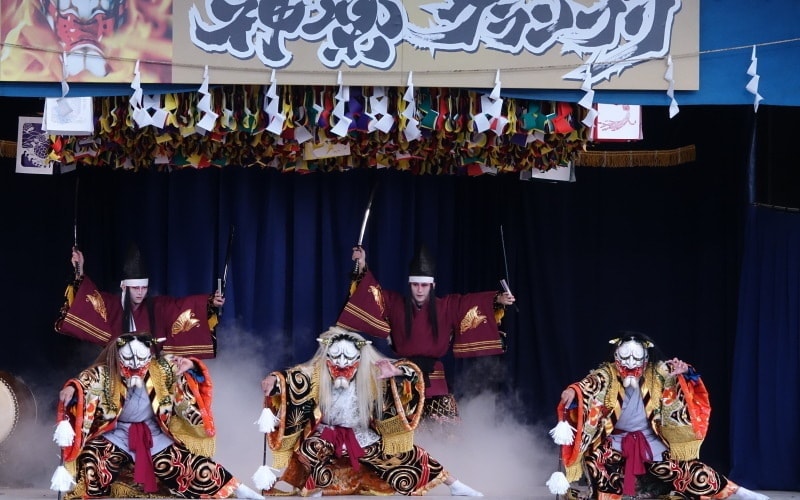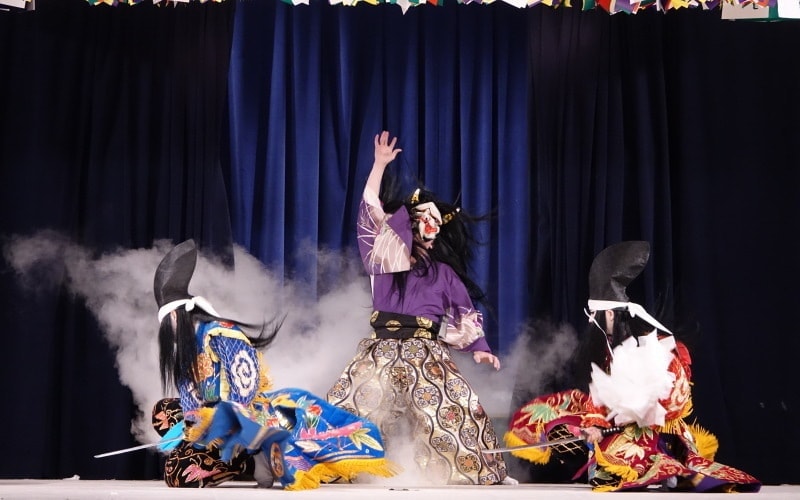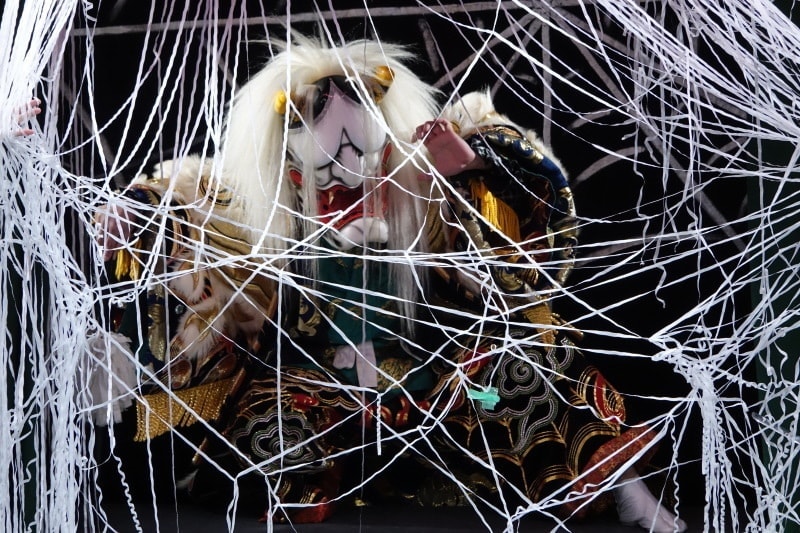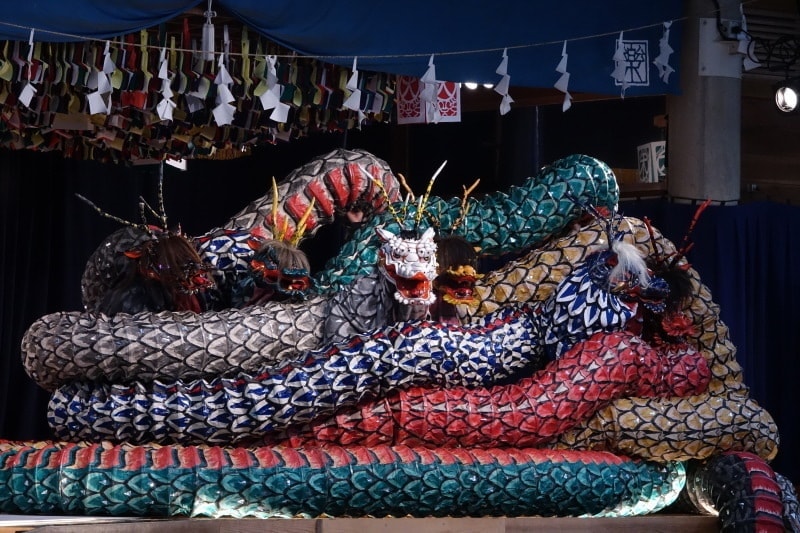"Kagura" is a traditional agricultural ritual that was born to offer thanks for the blessings of nature.
In the old days, our ancestors believed that everything in this world was a divine act. After the autumn harvest, people offered various kinds of food to sacred places and held festivals, from which a ritual called Kagura was born to show the people's gratitude to the gods.
Later, Kagura added elements of "Onmyodo," which taught the Chinese theory of Yin-Yang and the Five Elements. According to Onmyodo, the four cardinal points—north, south, east and west—and the four seasons—spring, summer, autumn and winter—were, through the laws of nature, closely related to people's daily lives.
In this way, and by incorporating Shinto rites and ceremonies, strongly characterized by sun worship, Kagura developed from a primitive and simple agricultural ritual into a ritual to pray for a wider range of things including the peace and security of the nation, and the health and wellbeing of the people.
Meanwhile, tutelary shrines were built across the country by people who desired to live in peace. With the spread of tutelary shrines, Kagura was propagated to various places around Japan.
Kagura has been fostered in the cultural climate of each community and passed down from generation to generation by Shinto priests and local people. It is still actively practiced by people in local communities as a form of Japanese folklore performing art, called "traditional performing art" or "local performing art."
Noh developed from Kagura about 600 years ago in the Muromachi period (1336-1573), and Kabuki also emerged about 500 years ago during the Civil War period (c.1467-c.1573). They have become well-known to the world as classical Japanese performing arts.
Kagura in the Geihoku area of
Hiroshima Prefecture
In ancient times, Izumo prospered as a cultural and industrial center. Izumo Kagura, performed as an agricultural and Shinto ritual, was introduced to its western neighbor, Iwami.
In Iwami, Kagura added myths and stories of Kojiki (the Record of Ancient Matters) and Nihonshoki (the Chronicle of Japan) and developed its own unique style. Kagura was originally meant to entertain the gods, but Iwami Kagura was unique because performers and spectators also enjoyed it.
Iwami Kagura spread to the Geihoku area in the north of Hiroshima Prefecture at the end of the Edo period (1603-1867). Kagura was mainly performed by Shinto priests, but in the Meiji era (1868-1912), shrine parishioners came to perform Kagura. With this, more entertaining repertoires became the mainstream of Kagura.
After the end of World War II in 1945, Kagura added various stories from the classical Japanese arts of Noh and Kabuki. It also added to the repertoire from the legends from different parts of Japan.
When Kagura contests were inaugurated to judge the performers' spirits and skills, Kagura developed its dramatic and artistic aspects, which were evaluated at these events.
At the same time, there was a tendency for Kagura groups in different communities to develop their own unique features by modifying traditional Kagura into a theatrical performing art different from Noh or Kabuki.
Kagura in the Geihoku area of Hiroshima Prefecture now has a repertoire of more than 70 performances: including agricultural rituals; myths and stories of the nation-building of ancient Japan (Yamato); legends and historical stories of the Heian period (794-c.1185); and original stories that are still being added by different Kagura groups.
There are more than 150 Kagura groups in the Geihoku area. Kagura is now a popular youth culture, transcending the old boundaries of farming and mountain villages, and contributing to the healthy mental and physical growth of new generations. In this way, a new, but traditional, Japanese culture is being developed in the form of Kagura.
In Hiroshima Prefecture, there are also other lines of Kagura with different roots, including Aki Juni Jingi, Hiba Kojin Kagura and Bingo Kagura.
Momijigari (Maple Viewing)
This story of Kagura was created from a legend about Mount Togakushi in Shinshu Province, where the high ranges of mountains are likened to the roof of Japan, in a beautiful Japanese autumn setting.
About one thousand years ago, the demons that lived in Mount Togakushi frequently attacked the nearby villages and looted them.
The villainy of the demons was reported to the capital, and General Taira no Koremochi, who protected the security of the country, headed from the capital to Mount Togakushi to attack the demons.
When Koremochi went into the mountain, he was deeply moved by the beautiful maple trees shining like a crimson sea reflecting the autumn sun and felt as if he had wandered into another world.
There he saw a beautiful woman, who invited him to a party under the maple trees. The woman was actually a demon in disguise.
Koremochi forgot his role as General and, without knowing that the woman was a demon, he drank sake, which she continued to ply him with until he passed out.
The demon revealed its true identity and was about to tear Koremochi apart and eat him. Then, a god that Koremochi always worshipped appeared and woke him up. With the Sword of Justice, which the god gave him, Koremochi defeated the demons.
Takiyasha-hime
About one thousand years ago, Kyoto, in western Japan, was the national capital. At that time of the Heian period (794-c.1185), Japan enjoyed peace, but in eastern Japan, a powerful samurai clan was forming. The head of the clan, Taira no Masakado, declared that he would control the eastern part of Japan by establishing a new country of his own.
At this unexpected news, the government sent an army to destroy Masakado and his clan.
This was called the Tengyo Revolt.
From this piece of history, a Kagura story was created based on the legend that Taki-hime, a daughter of Masakado, survived as the sole survivor of the clan.
In order to take revenge for her father, Taki-hime went through rigorous training to acquire supernatural powers. She changed her name to Takiyasha-hime and gathered soldiers to wage a war. The capital in the west knew this and sent an army and a powerful Yin-Yang master, who would not yield to her evil powers.
After a fierce battle, they defeated Takiyasha-hime.
Tsuchigumo
About 1500 years ago, before ancient Japan was unified, there were fierce battles around today's Yamato Basin in Nara over the control of the state. The people who lost the battles fled for their lives and hid themselves deep in the mountain of Katsuragi, which overlooked Yamato.
They were despised and called Tsuchigumo (Earth Spiders).
As time passed, the capital was relocated from Yamato to Kyoto, and again some hundred years passed.
This story of Kagura is about a Tsuchigumo challenging Minamoto no Raiko, the head of the samurais who protected the capital. The Tsuchigumo attempted to avenge the long history of humiliation and to seize power.
The Tsuchigumo turned himself into a demon and went from Yamato to Kyoto. At that time, Raiko was ill in bed and sent his maid, Kocho, to a doctor for some medicine.
The Tsuchigumo knew this and killed Kocho, who was on her way back, carrying the medicine. He changed the medicine for poison and attempted to make Raiko take it.
Just as Raiko was about to take it, he sensed that something was wrong, and with a famous sword, he slashed at the Tsuchigumo now disguised as Kocho. The wounded demon fled back to his home in Mount Katsuragi.
Raiko's retainers chased him to Mount Katsuragi and defeated him.
Yamata no Orochi
This story was taken from a Japanese myth.
Once upon a time, in the Province of Izumo, there was an old couple who had eight daughters. One summer's day, a monstrous serpent with eight heads and eight tails came from the big mountains and swallowed one of their daughters.
Every year, in the same season, the serpent appeared and swallowed one of their daughters. Finally there was only one daughter left, and now she was to be sacrificed. The old couple and their daughter were lamenting their fate.
Then a god descended from the high heavens. The god told the old couple to prepare some "sake" (rice wine) and put it in front of the daughter who was to be sacrificed. The monster appeared with a thunder storm and drank all the sake, thinking that the daughter's image reflecting on the sake was the daughter herself. The monster soon drank itself senseless. The courageous god attacked the monster and married the daughter he saved, and they lived happily ever after in Izumo.
Actually the monster is a metaphor of the mountain ranges of western Japan and the floods from these mountains. The daughter's name is Kushinada-hime. "Kushi" means "rare," "inada" means "rice fields" and "hime" is a suffix for a girl. Therefore her name means "rice fields blessed with a rare bumper crop." Therefore Yamata no Orochi (Eight-forked Serpent) tells the story of how Japan as a rice-producing country was born by protecting farmland from floods.





